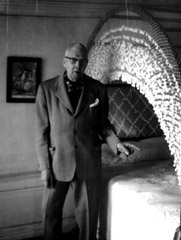INTRODUCTION | FAMILY AND FARM | WORK AND COMMUNITY | RELIGION AND REFORM | LEISURE AND IMAGE | NOSTALGIA AND HISTORY
Nostalgia and History: The Last Generation at Forty Acres
In 1921, the house was falling into disrepair. Notice the plants growing right out of the roof.
In a tragic coincidence both Frederic Dan Huntington and his eldest son George died on the same day in 1904. When the Bishop’s widow died in 1910, the house at Forty Acres passed directly to her grandchildren. It was used sporadically and fell into disrepair. In 1921, James Lincoln Huntington, a prominent Boston obstetrician, began repairs. He also removed several of the agricultural buildings, to make the house conform to his vision of genteel domesticity. Gradually the house evolved from a summer home, to a “colonial” showplace, and finally a museum. The museum you see today is a product of James Huntington’s vision.
"It did not seem possible that Moses Porter’s house could find no successor after so many years to continue to cherish it…It swept over me for the first time that I owned the house just as much as any other member of the family and that I was equally responsible for the present condition."
– James Lincoln Huntington in Forty Acres
Dr. James Lincoln Huntington
James Lincoln Huntington oversaw the restoration and renovation of the house.
Memories of summers spent at the farm were dear to James Lincoln Huntington. He became so compelled to restore Forty Acres that he left his Boston career, spent most of his money and imperiled his marriage. In these ways, he preferred the past to the present. His writings reveal that the house was a significant part of his personal identity. By protecting it, he protected himself, his family, and his corner of America. James Lincoln Huntington did not have to look far for inspiration: the 1920’s witnessed great interest in colonial arts and architecture. The most famous product of the colonial revival, Colonial Williamsburg, was founded in 1929.
As he restored his great-great-grandfather’s “colonial mansion,” he erased other parts of his family’s past. Furniture from the Victorian era was tucked away, and the places where work was done—the barn and the outbuildings—were sold or torn down. The house that remained emphasized his ancestors’ gentility, destroying the evidence of the complex labor and social relationships that linked the household at Forty Aces to the community and region.
James Huntington actively shaped the interpretation of this house until his death in 1968, even leading most tours of the house himself during his lifetime. In recent years, the museum directors have begun looking for new ways to interpret his legacy. Much of the information in this brief snapshot of the family and its history was created through new scholarship and an ongoing reinterpretation initiative, which would not be possible without the wealth of resources, including many of the family papers, currently located at the Amherst College Archives and Special Collections.
Forty Acres encompasses much more than the story of one family, one grand lineage. As we move ahead, we continue to try to honor James Lincoln Huntington's efforts while expanding our vision for the future.
